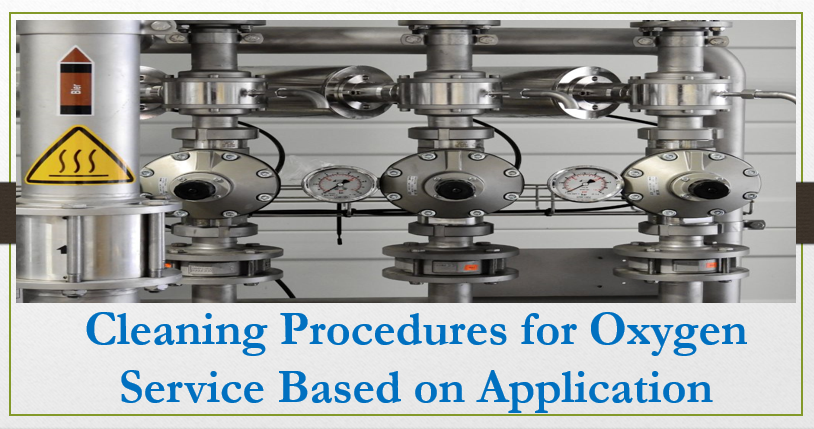This article is about Cleaning Procedures for Oxygen Service Based on Application related to topic of Cleaning System in Plants and Petrochemical Plants as per International Codes & Standards. Here furthermore will be discussed about Clean for Oxygen Service Standards, Cleaning Procedure for Oxygen Service, Cleaning Equipment for Oxygen Service, Cleaned for Oxygen Service, Chemical Cleaning Oxygen Pipelines, Oxygen Cleaning Malaysia, How to Clean Copper Fittings for Oxygen Use, Cleaning Agents for Oxygen Service, When Is Oxygen Cleaning Required in Plant and Petrochemical Plants.
Cleaning Procedures for Oxygen Service Based on Application
| Category | Field Application | Recommended Cleaning |
| A | Construction sites within which Air Separation Unit (ASU) equipment is being fabricated and/or installed. | For carbon steel with rust or scale, sandblasting to a white metal surface is the method of choice. For other materials, hot water/steam (aqueous) detergent cleaning is preferred. Rinsing of residual aqueous cleaning agents is especially important, as the detergent residues are not oxygen compatible. Availability of utilities/water, electric power, and heated enclosures are important. Due to the need to prevent unauthorized use, other cleaning methods/agents that require special precautions and training (for example, ensuring removal from equipment, limited personal exposure, flammability) are generally not suitable for use at these sites. |
| B | Stationary plant equipment, including piping, vessels, and cylinders. Generally involves large scale components and must be done on-site. | Hot water/steam detergent cleaning is preferred. Availability of utilities/water, electric power, and heated enclosures are important. Flammable (HVP) solvents may be used in small quantities. |
| C | Field installations, including customer stations piping and components. Generally, cleaning is done on a small scale in an open area. | HVP solvents in small quantities are acceptable because of a lack of a practical alternative. Utilities are not available, see section 5.3. |
| D | Large equipment fabrication facilities, including cryomachinery and vessel/column manufacturing. | Hot water/steam detergent cleaning is appropriate for large parts. Submersion in agitated baths (for example, ultrasonic) enhances cleaning. Caustic and acid-based cleaning might be appropriate provided that corrosion issues are adequately addressed. HVP solvents may be used in small amounts. |
| E | Small equipment fabricators, including instrument shops and laboratory scale equipment. | HVP solvents are preferred, see section 5.3. |
| F | Small equipment fabricators, including instrument shops and laboratory scale equipment. | Fixed detergent systems such as ‘washing machines’ or HVP solvents are preferred. |
| G | Oil removal from contaminated ASU equipment (plant washout). | Less complex systems such as brazed matrix Al or SS exchangers, liquefiers, main exchangers may be suitable for aqueous washing. Methylene chloride in a closed (recovery) system is preferred for difficult zones such as columns where dryout is a problem, see section 5.3. |
Cleaning Agents for Oxygen Service
| Material | Application |
| TICKET | Small components in workshop conditions |
| Methylene chloride | Small scale cleaning of Tubes/Fittings/Equipment |
| Methylene Chloride | Complex Plant washouts |
| ISOPROPANOL (Rocol Industrial cleaner rapid drying Spray) TDE (transdichloroethylene) | See paragraphs 5.2 through 5.2.1.5. Spot cleaning of accessible surfaces. |
| (Vertrel, Contact cleaner G3, 3M’s HFE-71DE) | Small scale cleaning of Tubes, fittings, equipment. |
| 1.1 Dichloro-1-Fluoroethane (H141b) (Genesolv 2004) | Spray cans only. Small components and tubing. |
| 2-(2-butoxyethoxy) ethanol) (Blue Gold (A), Simple Green (A)) | All applications where detergent methods are acceptable |
| Beyond 2001 (A) | |
| Safezone solvent flux remover | Spray cans only. Small components and tubing. |
| Safezone precision cleaning solvent | Spray cans only. Small components and tubing. |
| Tramos | Small scale cleaning of Tubes, fittings, equipment. |
| Pyrene 1027 (A) [Oakite Products,Inc] | Small scale cleaning of Tubes |
| Clear Clean (A) [Classic Chemicals, Inc] | Small scale cleaning of Tubes |
| eOx cleaner | Small scale cleaning of Tubes, fittings, equipment. |
Note: ‘small scale’ is a judgment but refers for example to cleaning of a small number of tubes or equipment where larger fixed cleaning equipment is not practical to use, so for example emergency repairs or customer site maintenance.
Cleaning Agents Not Useful for Oxygen Service
| Material | Application |
| P3 GLIN | Any (due to leaving residue) |
| AMBERCLEAN FE10 | Any (due to leaving residue) |
| ROCOL U/C 2000 | Any (due to flammability concerns) |
| MICRO | Any (due to ineffectiveness) |
| ISOPROPANOL (Rocol Industrial cleaner rapid drying Spray) | Any except for Spot cleaning of accessible surfaces. See paragraphs 5.2 through 5.2.1.5. (due to flammability concerns) |
| SONOCLOR | Any (due to environmental and health effects) |
| n-propyl bromide (Ensolv, Swansolv, HFE 7100) | Any (due to environmental and health effects) |
Note: Cleaning Agents Not Approved for Oxygen Service Appendix B Table 2 lists only the cleaning agents methods that have been evaluated, by definition the only approved cleaning agents and methods are those listed in Appendix B Table 1.
Cleaning Requirements of Piping Systems in Plants & Refineries
